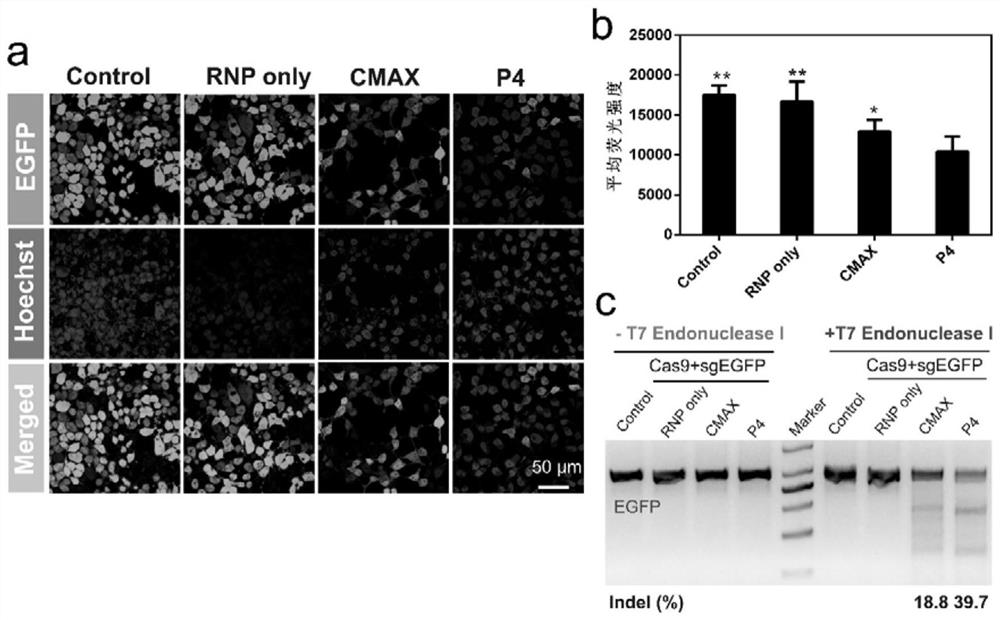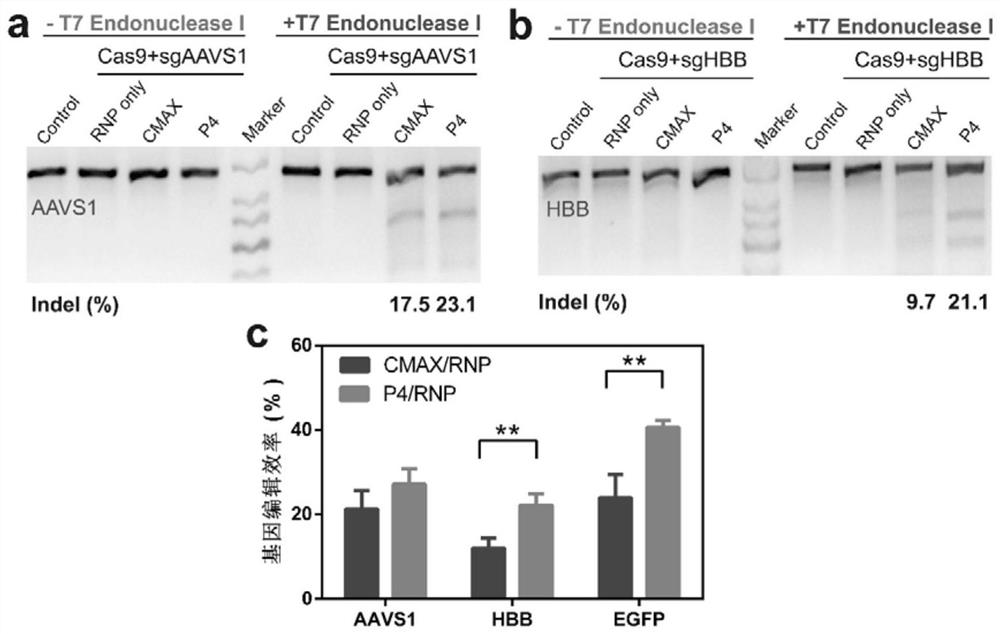Phenylboronic acid-modified high polymer material and application thereof in intracellular delivery of gene editing ribonucleoprotein compound
A polymer material and ribonucleoprotein technology, applied in the field of intracellular delivery of gene-edited ribonucleoprotein complexes, can solve the problem that polymer carriers cannot bind ribonucleoprotein complexes well
- Summary
- Abstract
- Description
- Claims
- Application Information
AI Technical Summary
Problems solved by technology
Method used
Image
Examples
Embodiment 1
[0055] Example 1: Synthesis of protein and polypeptide intracellular delivery carriers P1-P6 based on polyamide-amine dendrimers and functional groups containing phenylboronic acid.
[0056] In a specific embodiment, the preparation method of the polymer material modified with phenylboronic acid is as follows: 4-bromomethylphenylboronic acid and the 5th generation polyamidoamine dendrimer are mixed according to different molar ratios (26: 1,38:1,96:1,128:1) into methanol solution, heated at 70°C for 24 hours, transferred to a dialysis bag, fully dialyzed in methanol and deionized water, separated and purified to obtain the product, respectively obtained 4 kinds Phenylboronic acid-modified dendrimers with different grafting ratios (as shown in formula (9)). according to 1 H NMR nuclear magnetic spectrum characterizes the connection efficiency of phenylboronic acid on the surface of polyamide-amine dendrimer, and calculates the average number of phenylboronic acid linked to eac...
Embodiment 2
[0063] Example 2: Comparison of intracellular delivery efficiency of gene editing ribonucleoprotein complexes (CRISPR-Cas9) containing phenylboronic acid-modified dendrimer materials P1-P6.
[0064]The specific operation method is as follows: firstly, sgRNA targeting AAVS1 (sgAAVS1) was prepared by in vitro transcription (the target of AAVS1 is GGCTCCCTCCCAGGATCCTCTC), and the activity of sgAAVS1 was determined by cutting the PCR fragment of the target gene in vitro. The 293T cells were seeded into 6-well plates overnight, and the protein delivery experiment was started when the 293T cell density reached more than 80%. Firstly, the CRISPR-Cas9 protein and sgAAVS1 were incubated at 37°C for 10 minutes to form a CRISPR-Cas9 / sgAAVS1 complex, and then the CRISPR-Cas9 / sgAAVS1 complex was mixed with six phenylboronic acid-modified dendrimers, P1-P6, respectively. After the materials are fully mixed, add 100 μL of serum-free DMEM medium, shake and mix well. The dose of CRISPR-Cas9 w...
Embodiment 3
[0066] Example 3: Preparation of a complex containing dendrimer material P4 modified with phenylboronic acid and gene editing ribonucleoprotein complex (CRISPR-Cas9), and using dynamic light scattering (DLS) to characterize the size and surface potential of the complex.
[0067] The specific operation method is as follows: mix the CRISPR-Cas9 protein with the P4 solution evenly, incubate at room temperature for 30 minutes, add 1 mL of deionized water to dilute, and use a laser nanometer to detect the size distribution and surface potential of the nanoparticles in the solution.
[0068] Experimental results: figure 1 Represents the size distribution and surface potential of the DLS-characterized complex formed by P4 and CRISPR-Cas9 protein prepared in the present invention. The results showed that the phenylboronic acid-modified dendrimer material P4 could form nanoparticles with a size of about 300 nm with CRISPR-Cas9 protein, and the surface potential of the particles was pos...
PUM
 Login to View More
Login to View More Abstract
Description
Claims
Application Information
 Login to View More
Login to View More - R&D
- Intellectual Property
- Life Sciences
- Materials
- Tech Scout
- Unparalleled Data Quality
- Higher Quality Content
- 60% Fewer Hallucinations
Browse by: Latest US Patents, China's latest patents, Technical Efficacy Thesaurus, Application Domain, Technology Topic, Popular Technical Reports.
© 2025 PatSnap. All rights reserved.Legal|Privacy policy|Modern Slavery Act Transparency Statement|Sitemap|About US| Contact US: help@patsnap.com



